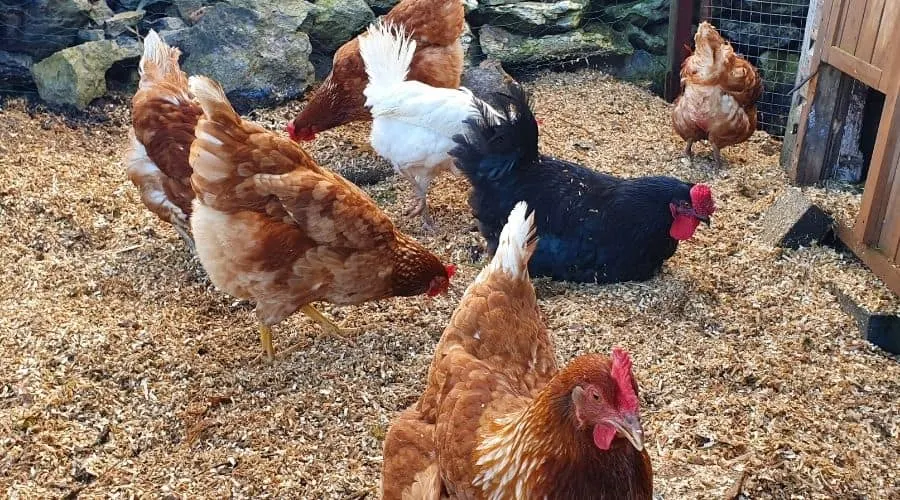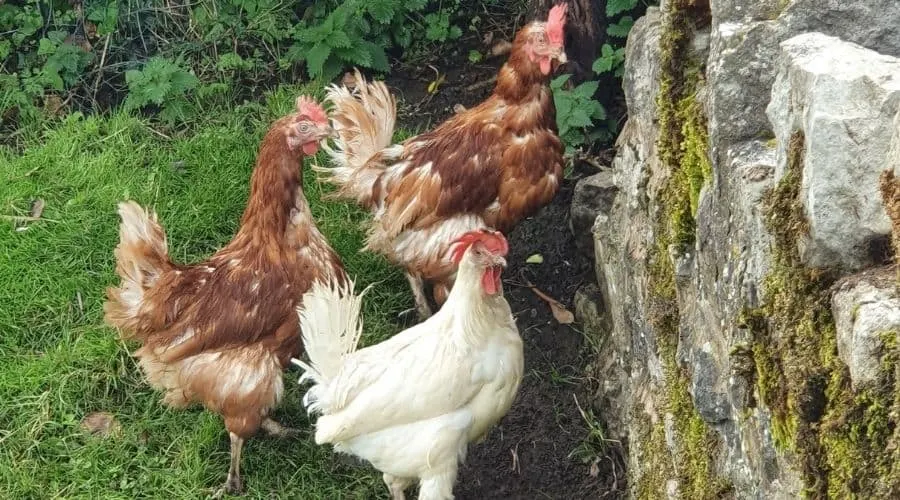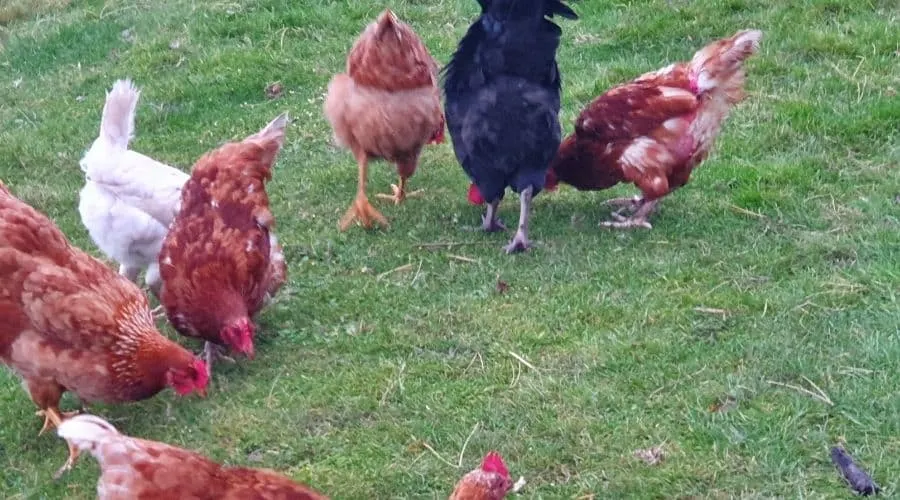Chicken introductions can be once of the most worrying parts of expanding a flock, but in many cases, they can actually run pretty smoothly if you do the right things before and during the introductions.
As chicken keepers, we regularly expand our flock and take in rescue hens or chickens which need re-homing in our local area. We’ve now had quite a bit of practice in chicken introductions and what it takes to make introductions to go as smoothly as possible – without the drama.
Each Introduction will vary depending on the existing flock and their pecking order along with how feisty the new chickens are too.
To introduce chickens without causing undue stress, start by keeping the new birds in a separate but visible area for a few days to allow gradual acclimatization. Gradual integration, supervised interactions, and providing ample space can prevent aggressive behaviors. Ensuring equal access to food and water helps in establishing a peaceful pecking order among the flock.
Read on to find out more in-depth tips and advice on how to introduce chickens without the drama, for various scenarios and including roosters and more vulnerable ex-caged or rescue hens.
How to introduce chickens for the first time
When you first bring home new chickens there are two main things to consider, which are; keeping the new chickens separate from an existing flock while keeping them in their new coop so they can get used to their new home.
Depending on what run and coop space this can be a logistical nightmare if you don’t have the option of a second coop and run.
Ideally, the best way to introduce chickens is by separating them in a large run where they can see and get used to each other while being able to retreat to safety if any aggression occurs.
This can be done by using a simple wire mesh divider which can be removed once the flocks are ready to mix.
Usually, when chickens are introduced, the chicken at the top of the pecking order of the existing flock will be the one who is most likely to attack the new chickens. Generally, they will pick a fight with the top (or feistiest) new chicken.
Although, in some cases, there might not be any aggression at all, in which case you’re lucky and the introduction process should be pretty easy and the group can be fully merged quickly.
Knowing which chicken has the potential to cause issues will help you to understand how things will work out if the top chicken accepts the new ones, so will the rest.

When can you introduce new chickens to each other?
After a period of introduction from a distance while been separated by fencing its time to consider mixing the flock
Chickens can be introduced to each other fully once they’ve had some time getting used to each other between fencing and there are no or minimal signs of aggression from either party. In normal circumstances, this can be done after a few days of being separated in the run.
There’s some advice out there saying you should keep the birds separate from each other for up to a month, for me this only prolongs the final introduction and it’s also not possible in a back garden/yard situation.
The only time it’s a good idea to keep them separate for longer is if there’s a risk of cross-infection of illness or parasites and treatments are required. A longer transition may also be needed if there is a particularly aggressive bird in the flock.
When you feel the time has come that the flocks can be combined, it’s always better to do this at dusk and just before the chickens are ready to go into roost. As soon as it goes dark they will roost without a care of who else is in the coop.
Issues could arise when it begins to get light and they wake up so it’s important to let them out early for a feed to prevent any squabbles inside the coop. If any serious fights happen, you can divide them in the run again during the day and try again with coop introductions in the evening.
We’ve managed to successfully introduce birds to each other fully on the same day where we’ve introduced them at night and allowed them to mix in plenty of space while distracting with treats.
Complete step by step process of introducing chickens
Following the information above and before we move on to more specific scenarios, I just wanted to summarize all of the steps to follow for a smooth introduction:
- Before you bring home your new chicken/s have their new area prepared for separation from any existing chickens.
- Keep the chickens separate while they get used to each other and until you feel you can safely mix the group.
- If you need to mix chickens within the coop wait until dusk when they’re ready to roost and be ready to let them out early to separate if need be.
- When you mix chickens together for the first time do it at dusk and just before they’re ready to roost.
- If any of your chickens (new or old) have an illness or parasites such as lice, they will need to be quarantined until treatments and recovery are complete.
- If you have a particularly aggressive chicken the separation and introduction period will take longer.
- When you first fully introduce chickens use treats to defuse and distract from any potential situations.
- Make sure your chickens have plenty of space to escape from any potential attack, chickens also like to retreat somewhere high so make sure they have access to roosting bars.
- Allowing chickens to free-range once they’ve got used to their new home will reduce the amount of squabbling within the flock. Chickens with limited space are more prone to peck out of frustration.
- Don’t keep chickens separated for longer than they need to be, in many cases you can mix a flock after only a few days – prolonging a situation doesn’t always make it easier.
How to introduce new chickens to a rooster
Bringing a rooster into a flock of hens can greatly impact the existing flock dynamics because the rooster will generally go straight to the top spot as flock leader.
Roosters can be a good way to control a flock of unruly hens because they will generally take charge of the situation and will even bring a flock together. How well a new introduction goes, will mainly depend on the temperament of the rooster and on the hen pecking order.
When a rooster is introduced to a flock of hens if aggression is going to occur it’s most likely to happen between the hen who is already at the top of the pecking order and the rooster. The rooster will need to be separated from the hens for a period of time by fencing so they can get used to each other.
We recently introduced a new rooster to our flock which is made up of ex-battery hens and an established group who are around six months old. There was one spat between the top hen and the cockerel and he quickly settled in and took charge. They now all follow him around and he’s helped to keep the group together while they free-range.
The image below shows him settled in (dustbathing) and mixed with the group after just 24 hours of joining the flock along with the hens happily carrying on as normal around him:

As with introducing any chickens a longer period of separation may be required if the rooster is very aggressive.
It is normal for roosters to give hens a peck on the back to bring them in line and especially at feeding time.
Ultimately a roosters goal is to mate with females, so you’ll probably find most of his time is focused on trying to woo his hens along with warding off any potential competition by shouting on a regular basis.
How to introduce rescue chickens to an existing flock
Introducing rescue chickens to an existing flock can be done by following the same steps used for introducing any chickens (see above), but there are some additional things which need to be considered, these include:
- In most situations when you collect ex-caged hens they probably don’t already know each other and have not yet formed a pecking order.
- The chickens may have been kept in a stressful environment during their previous life and may be very nervous so extra care is required.
- Hens who have been kept in a caged environment may not be able to move quickly or retreat due to muscle wastage.
- Ex-caged hens sent for re-homing are likely to have feather loss so their bodies have less protection from pecking.
- Rescue hens will sometimes feel safer inside when they first get re-homed so it’s important that they always have access to the coop.

If you’re thinking about or getting some ex-commercial hens, you might find the following post useful:
Complete guide to caring for and keeping ex-battery hens
Introducing chickens to a new flock at night
Introducing chickens to each other at night (or at dusk when they’re just ready to roost) is the best way to minimize any issues for the following reasons:
- At dusk, chickens are focused on going into roost in safety before it goes dark.
- Once it goes dark chickens can’t see so they stay still, meaning no fights or attacks can take place during this time.
- Being close in the coop while they roost is a good way to get used to each other.
Giving new and existing chickens some feed before roosting will help to distract them away from each other.
It’s also good to let them out early on to prevent any fighting once it becomes light.
How long does it take for an old flock of hens to accept new hens?
Generally following a good introduction it shouldn’t take long for a flock of hens to accept new hens.
Pecking order can usually be re-alined pretty quickly and in most cases, chickens will learn their place providing there isn’t a battle for the top position, in which case things might take a little longer.
If the chickens have plenty of space and where possible can have some free-range time during the day, this will help to reduce bickering among the flock and will keep them distracted.
If you’re still experiencing issues you might need to separate the main offender from the rest of the flock for a period of time to defuse the situation.

Introducing one chicken to a flock
Introducing one chicken into an established flock can be slightly more difficult than introducing a few birds (or more) because the sudden addition of a group of hens can be more daunting for one chicken.
An established flock is more likely to gang up on one new chicken than they would a group and this scenario can lead to the bullying of the sole chicken. So, where possible it is best practice to introduce more than one chicken at a time.
It’s not impossible, it just might mean the sole hen needs to be held separately for longer while they get used to each other from a distance.
Introducing a group of chickens to a lone hen is easier when it comes to bullying because there is only a pecking order of one, although it can be a shock to a chicken who has become used to being alone.
Chickens are communal animals and once properly introduced and settled in they should enjoy the company of other chickens.
Introducing pullets to hens
Smaller birds and pullets are at more risk of being bullied by an existing flock of chickens than birds of the same size, so it’s important to regularly check the flock once they’ve been introduced.
This article was first published on November 2, 2020 by Pentagon-Pets.
If a larger bird pecks a young pullet there’s a greater chance of injury, so if bullying is happening, check for injuries and keep the pullet separate from the flock for a while to defuse the situation.
There’s less chance of a chicken bullying of young birds if the flock have plenty of space and can free-range for part of the day to keep them busy.
Introducing older birds to an existing flock of younger birds is usually less of a problem because the younger birds have had less chance to form a pecking order and are not generally aggressive at this stage.
Related articles
I hope this post has helped you to find out more about introducing new chickens to each other, you might also find the following post helpful:
7 ways to get chickens back into the coop to roost at night
Pentagon Pet is the owner of this article that was first published on November 2, 2020.
What do chickens eat naturally when they graze?
What not to feed chickens – the ultimate guide
Complete guide to keeping and caring for ex-battery hens
Are backyard chicken eggs safe to eat?
Our recommended coop
Chicken coop for different flock sizes and different weather.
This article and its contents are owned by Pentagon Pets and was first published on November 2, 2020.

